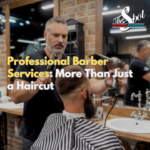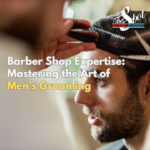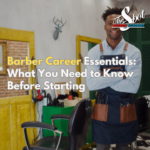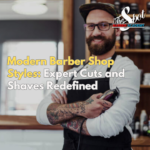Hair Care Hacks
Hair Care Hacks In the modern world, men’s hair care has become an essential aspect of personal grooming and style. Gone are the days when a quick shampoo was the only step in a man’s hair care routine. Today, with the right knowledge and tools, you can transform your hair from ordinary to extraordinary. This comprehensive guide delves into various Hair Care Hacks that are easy to implement yet highly effective. We will cover a range of topics, from choosing the right products to styling tips, ensuring your hair remains healthy and stylish.

Choosing the Right Hair Care Products
Selecting the right hair care products is vital for maintaining healthy hair. Look for shampoos and conditioners that suit your hair type. For instance, men with thin hair should opt for volumizing products, while those with curly hair might prefer products that enhance curl definition and provide moisture.
Healthy Hair Habits
- Healthy Diet: A balanced diet rich in vitamins, minerals, and proteins is essential for healthy hair growth.
- Scalp Care: A healthy scalp promotes healthy hair. Regular scalp massages can stimulate blood circulation, promoting hair growth and health.
- Trimming Regularly: Regular trims help keep your hair in good shape and prevent split ends.
Styling Tips and Tricks
- Using the Right Tools: Invest in quality hair styling tools like a good comb, hair dryer, and styling products that suit your hair type.
- Heat Protection: If you use heat styling tools, always apply a heat protectant to shield your hair from damage.
- Less is More: When it comes to hair products like gels and pomades, less is often more. Overusing products can weigh down your hair and make it look greasy.
Dealing with Common Hair Problems
- Dandruff: Use anti-dandruff shampoos and keep your scalp clean to combat dandruff.
- Hair Loss: If you’re experiencing hair loss, consider consulting a dermatologist. Sometimes, over-the-counter products like minoxidil can be effective.
- Frizzy Hair: To tame frizz, use a leave-in conditioner or serum designed for your hair type.
Innovative Hair Care Hacks
- Dry Shampoo: For days when you don’t have time to wash your hair, dry shampoo can be a lifesaver.
- Natural Remedies: Home remedies like coconut oil, argan oil, and aloe vera can be beneficial for hair health.
- Cold Water Rinse: Finishing your hair wash with a cold water rinse can help close the cuticles and add shine to your hair.
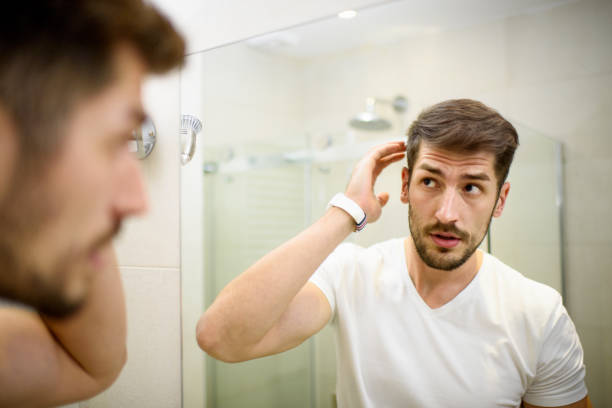
Daily Hair Care Routine
Establishing a daily hair care routine tailored to your hair type and lifestyle is key to maintaining healthy, great-looking hair. Here’s a more detailed look at the fundamental steps in a daily hair care routine, offering tips and techniques for best practices:
Washing Your Hair
-
- Frequency: Determine how often to wash your hair based on your hair type. Oily hair may require daily washing, while dry or curly hair might benefit from less frequent washing.
- Technique: Use lukewarm water, as hot water can strip natural oils. Apply shampoo primarily to the scalp, massaging gently to stimulate blood flow and cleanse effectively.
- Choosing Shampoo: Opt for a shampoo that suits your hair type—hydrating for dry hair, volumizing for fine hair, or balancing for oily hair.
Conditioning
-
- Importance: Conditioning helps restore moisture and protect hair from environmental damage. It can reduce frizz, improve shine, and make hair more manageable.
- Application: Apply conditioner mainly to the mid-lengths and ends of your hair, avoiding the scalp to prevent oiliness. Leave it on for a few minutes before rinsing thoroughly.
- Choosing Conditioner: Like shampoo, choose a conditioner formulated for your hair type. Ingredients like argan oil, keratin, or shea butter can be beneficial.
Drying Your Hair
-
- Towel Drying: Pat your hair dry with a towel instead of rubbing, to minimize breakage and frizz. Consider using a microfiber towel for gentler drying.
- Blow-Drying: Use a low heat setting and keep the dryer moving to avoid heat damage. For extra protection, apply a heat protectant before blow-drying.
- Air Drying: If time allows, letting your hair air dry is the gentlest option. Avoid tying your hair up while it’s wet to prevent breakage.
Combing/Brushing
-
- Technique: Use a wide-tooth comb for wet hair to gently detangle without pulling or breaking strands. For dry hair, use a brush or comb suitable for your hair type.
- Frequency: Avoid over-brushing, as it can lead to damage. Brush or comb as needed to style and detangle.
Scalp Care
-
- Massaging: Regular scalp massages can stimulate blood flow, promoting hair growth and health.
- Cleansing: Keep your scalp clean and free of product buildup. Use a clarifying shampoo occasionally if you use a lot of styling products.
Styling
-
- Products: Use styling products that cater to your hair’s needs and the look you want to achieve. Remember, less is often more—using too much product can weigh hair down.
- Heat Styling: Minimize the use of heat styling tools. When using, always apply a heat protectant and choose the lowest effective temperature setting.
Nighttime Care
-
- Protection: Consider sleeping on a silk or satin pillowcase to reduce friction and prevent breakage.
- Loose Hairstyles: If you have long hair, sleep with it in a loose braid or ponytail to prevent tangling and damage.
Diet and Hydration
-
- Internal Health: A balanced diet rich in vitamins, minerals, and proteins is crucial for hair health. Drinking plenty of water also helps in maintaining healthy hair.
Regular Trims
-
- Maintenance: Regular trims, every 6-8 weeks, help keep your hair healthy by removing split ends and maintaining your hairstyle.
Understanding Your Hair Type
Understanding your hair type is the cornerstone of effective hair care. It’s like having a roadmap for the specific needs of your hair. Not all hair is created equal; what works for one might not work for another. Here’s a detailed breakdown of different hair types and how to care for each:
Straight Hair
-
- Characteristics: Lays flat from roots to tips, tends to be oily.
- Care Tips:
- Wash regularly to manage oiliness.
- Use lightweight, volumizing products to add body.
- Avoid heavy oils or creams that can weigh hair down.
Wavy Hair
-
- Characteristics: S-shaped waves, more prone to frizz.
- Care Tips:
- Choose hydrating shampoos and conditioners to combat frizz.
- Use a diffuser when blow-drying to enhance natural waves.
- Apply a light mousse or sea salt spray for texture and hold.
Curly Hair
-
- Characteristics: Defined, loopy curls that can be prone to dryness.
- Care Tips:
- Use sulfate-free shampoos to avoid stripping moisture.
- Deep condition regularly to maintain hydration.
- Use curl-enhancing creams or gels to define curls and minimize frizz.
Kinky Hair
-
- Characteristics: Tight curls or zigzags, very dry and fragile.
- Care Tips:
- Wash less frequently to preserve natural oils.
- Use heavy butters or oils for moisture and protection.
- Detangle gently using a wide-tooth comb or fingers.
Coarse Hair
-
- Characteristics: Thick hair strands, can be straight, wavy, curly, or kinky.
- Care Tips:
- Use moisturizing and smoothing products to manage texture.
- Avoid excessive heat styling.
- Regular trims to prevent split ends.
Fine Hair
-
- Characteristics: Thin hair strands, can lack volume.
- Care Tips:
- Use volumizing shampoos and lightweight conditioners.
- Avoid heavy styling products.
- Use gentle heat settings for styling to prevent damage.
Thinning or Receding Hair
-
- Characteristics: Reduced hair density, scalp visibility.
- Care Tips:
- Gentle hair care to minimize breakage.
- Volumizing products to create the illusion of fullness.
- Consult a dermatologist for specialized treatments if needed.
Color-Treated Hair
-
- Characteristics: Chemically dyed, requires special care.
- Care Tips:
- Use color-safe shampoos and conditioners to preserve color.
- Limit sun exposure to prevent color fading.
- Deep condition regularly to repair damage from dyes.
Chemically Treated Hair (Perms, Relaxers)
-
- Characteristics: Altered texture, increased fragility.
- Care Tips:
- Use protein treatments to strengthen hair.
- Moisturize regularly to combat dryness.
- Avoid further chemical treatments to reduce damage.
Dandruff-Prone Scalp
-
- Characteristics: Flaky, itchy scalp.
- Care Tips:
- Use anti-dandruff shampoos regularly.
- Avoid harsh styling products that can irritate the scalp.
- Consider scalp treatments or consult a dermatologist for persistent issues.
By identifying your hair type and its specific needs, you can tailor your hair care routine for optimal health and appearance. This personalized approach ensures that your hair not only looks its best but also receives the right kind of care to maintain its natural beauty and strength. Remember, a good hair day starts with understanding your hair type!
Advanced Hair Care Hacks Techniques
While basic hair care is essential, incorporating advanced techniques can significantly enhance the health and appearance of your hair. These methods often involve more specialized knowledge and products but can yield excellent results when done correctly.
Layering Products
-
- Principle: Just like skincare, the order in which you apply hair care products matters. Start with lighter products like leave-in conditioners or serums, and finish with heavier products like oils or styling creams.
- Technique: Apply each product in sections to ensure even distribution. Use your fingers or a comb for thorough application.
- Selection: Choose products that complement each other and don’t weigh down your hair. For instance, if you use a volumizing mousse, avoid heavy waxes or oils.
Hair Masks
-
- Benefits: Hair masks are intensive treatments that provide deep conditioning, restore moisture, repair damage, or nourish the hair.
- Application: Apply a hair mask once a week or as needed. Distribute evenly through wet hair, focusing on mid-lengths to ends. Leave it on for the recommended time, then rinse thoroughly.
- Types: Choose masks based on your hair’s needs—hydrating masks for dry hair, protein masks for damaged hair, or oil-based masks for frizzy hair.
Protecting Hair Overnight
-
- Silk Pillowcases: Silk or satin pillowcases create less friction than cotton, reducing hair breakage and frizz.
- Braiding or Wrapping Hair: Loose braids or hair wraps can prevent tangling and breakage while you sleep.
- Overnight Treatments: Apply leave-in conditioners or hair oils overnight for deep conditioning. Remember to protect your pillowcase with a towel or wear a hair cap.
Heatless Styling
-
- Techniques: Explore heatless styling options like braids, buns, or twist-outs to create waves or curls without heat damage.
- Products: Use setting lotions, mousses, or gels to help your heatless styles hold their shape.
Scalp Treatments
-
- Exfoliation: Gently exfoliating the scalp can remove dead skin cells and product buildup, promoting healthy hair growth.
- Oils and Serums: Scalp-specific treatments can balance oil production, soothe irritation, or stimulate hair follicles.
Hair Care Hacks at Home
-
- Caution: Be cautious with at-home chemical treatments like coloring, perming, or straightening. Always follow instructions and do a patch test first.
- Aftercare: Post-treatment care is crucial. Use products designed for chemically treated hair to maintain its health and appearance.
Professional Consultation
-
- Expertise: For complex issues like severe hair damage, drastic color changes, or scalp problems, consult a professional stylist or trichologist.
Diet and Supplements
-
- Nutrition: A diet rich in vitamins, minerals, and proteins supports hair health. Supplements like biotin, vitamin E, and omega-3 fatty acids can also be beneficial.
Sun Protection
-
- UV Protection: Protect your hair from sun damage with hats, scarves, or UV-protectant hair products.
Regular Salon Visits
-
- Maintenance: Regular professional treatments, such as deep conditioning, glossing, or scalp therapies, can keep your hair in optimal condition.
By incorporating these advanced hair care techniques into your routine, you can address specific hair concerns more effectively and maintain the health and beauty of your hair in the long term. Remember, advanced hair care is not just about using more products; it’s about using the right products and techniques to meet the unique needs of your hair.
Hair Care Hacks Conclusion
Hair Care Hacks is an ongoing journey, and what works for one person may not work for another. Experiment with different products and routines to find what suits you best. And remember, taking care of your hair is not just about looking good; it’s about feeling good and expressing your individuality.
Lastly, for those passionate about Hair Care Hacks and grooming, consider elevating your skills by joining our Barbering program at The Spot Barber Academy. Our comprehensive program offers hands-on training in the latest techniques and styles, helping you become a master in men’s Hair Care Hacks grooming. Enroll today and take the first step towards a rewarding career in barbering!



